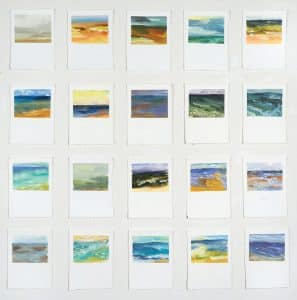by G.W. Mercure
When artist Nick Patten was packing up his own Patten Gallery in Chatham, Mass., in 2004, one of the first calls he made was to Marla Rice at the Rice Polak Gallery.
“It was one of the greatest things that has ever happened to me,” he says. Patten had only a moment to introduce himself. “I know who you are,” Rice said to him. “And if you’re calling for the reason I think you’re calling, the answer is ‘Yes.’” Rice adds a detail about the exchange that Patten may not know: “I did a little dance,” she says. “Nick had an excellent reputation throughout the Cape. His work was stunning and completely different from anything else that was in the gallery, and at that point in my career it really elevated the level of art that I was showing…He is an extremely serious, professional, and hard-working artist. I purchased one of Nick’s paintings and it is one of my most treasured pieces.”

This year, Patten marks thirty years of painting. In a tidy kiss of kismet, the Rice Polak Gallery also passes the three-decade threshold this year. The relationship between Rice Polak and Patten has been fruitful and mutually satisfying. “I keep saying that it is a lucky dream,” says Rice of her thirty-plus years in business.
During those thirty years, the obsessively detailed, slightly romantic realist has grown in ability—although his work has always been strong—and reputation. The shift from owning and maintaining his own gallery to showing with Rice Polak was necessary, especially as he cared a great deal more about creating the work than selling it.
“It was a working gallery. It was my studio,” he says. “And I was trying to work and I kept getting interrupted.” Those pesky people popping in to purchase his paintings were not only interrupting his work, but his learning. “I’m a completely self-taught painter,” he says. “I don’t recommend it! It’s about the worst way to go about it!”

He learned a lot from the only other artist he showed in his gallery, the established lithographer turned painter Robert Kipness, whom Patten calls a friend and mentor. “He was nationally known,” Patten says. “His work is in every major museum in the country.” While Patten had a demonstrably advanced grasp on color, composition, technique, and manipulation of light, among other gifts, the influence of Kipness provided an underappreciated but vital lesson. “He taught me what to do to keep a painting from cracking, or flaking,” he says. “In thirty years I’ve repaired one painting.”
Patten’s works are striking, emotional, and entrancing. Regarding them, one has the feeling of discovering a space—almost always an interior—and the feelings evoked by that space: awe, ennui, captivation, quietude, and whimsy, practically in equal measure. His careful hand with light is never overplayed: while a streak or two of light in, for example, a John Singer Sargent scene might snare an eye from across a room, Patten’s light is subtle, soft, ethereal, demands some study. He’s been compared to Johannes Vermeer, but one might say that while Vermeer created souls with things, Patten creates things with souls. They are not dramatic images, they’re images of drama. One reason he has been so successful is his unique process.

“I see things throughout the day, scenes I want to paint, ideas,” he says. “I compose them until they are what I want to see.” The dynamic nature of his process continues well after composition. “I don’t use any medium with my paints,” he says. “I don’t mix paints. I have eleven tubes of gray.” The use of unadulterated color is only the beginning: the technique on the canvas—he mostly uses panels—is unique as well. “I don’t do any glazing or layering,” he says. “When you see a shadow I’ve painted, you’re seeing straight color.” Those shadows achieve tension in his paintings, “push and pull,” he says. The paintings are invariably quiet, but they’re hardly ever tranquil.
After stops around New York State (he was born in Troy), and Cape Cod, Patten now lives and works in Providence, Rhode Island, on the burgeoning west side, with his wife, Amy. He still travels frequently to the outer Cape, and will do so July 22 for the opening for his show at Rice Polak.
Nick Patten’s work is on view in a group show with Ruth Williams, William Ciccariello, and Robin Winfield at Rice Polak Gallery, 430 Commercial St., Provincetown, July 21 – August 3, with an opening reception Friday, July 22, 7 p.m. For more information call508.487.1052 or visit ricepolakgallery.com.











